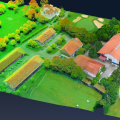
Australian scientists have developed software that enables mobile phones to communicate directly, without using phone towers or satellites.
The system works by using the phones' Wi-Fi capability as a mini tower, allowing connection with other phones to form their own network.
Paul Gardner-Stephen of Flinders University in Adelaide, South Australia said the system could provide communications for areas without telephone infrastructure in place or where communication networks have been destroyed by disasters or civil unrest.
"People in a disaster-ravaged area will be able to contact friends and family and aid workers will be better able to coordinate relief efforts,” he told CNET.
The team tested a prototype of the system this month and were able to communicate between phones several hundred metres apart. The next stages in the project involve increasing the range and improving sound quality.
The technology uses open-source software called distributed numbering architecture (DNA) which allows people to use their existing phone numbers so they can be reached easily, a key factor in emergency situations.
By integrating DNA with hardware, called "mesh potatoes", the team say they will be able to expand the network by allowing each phone to work as a tower or router for other calls.
The scientists are also working on a temporary self-powered mobile network for disaster areas, formed with small phone towers dropped in by air.
Gardner-Stephen said the system could be operational within 18 months if the project receives funding.










